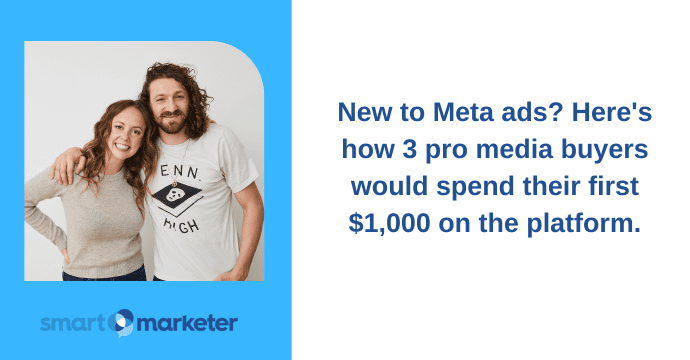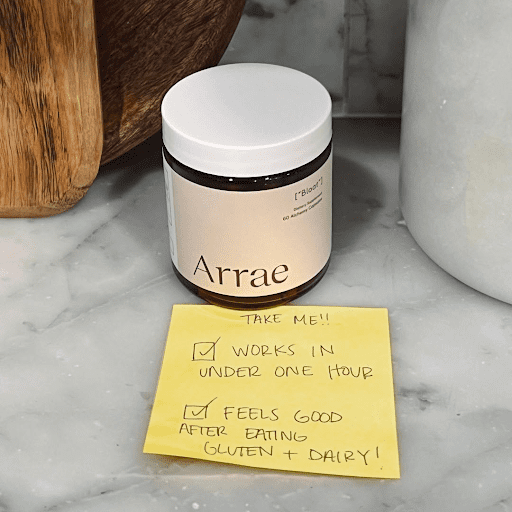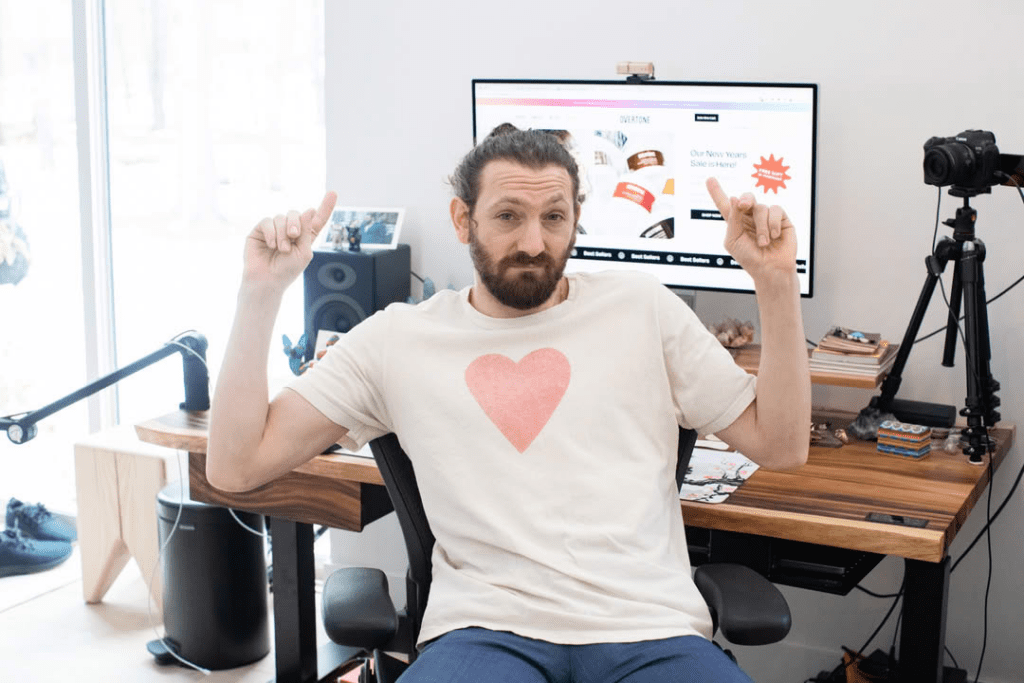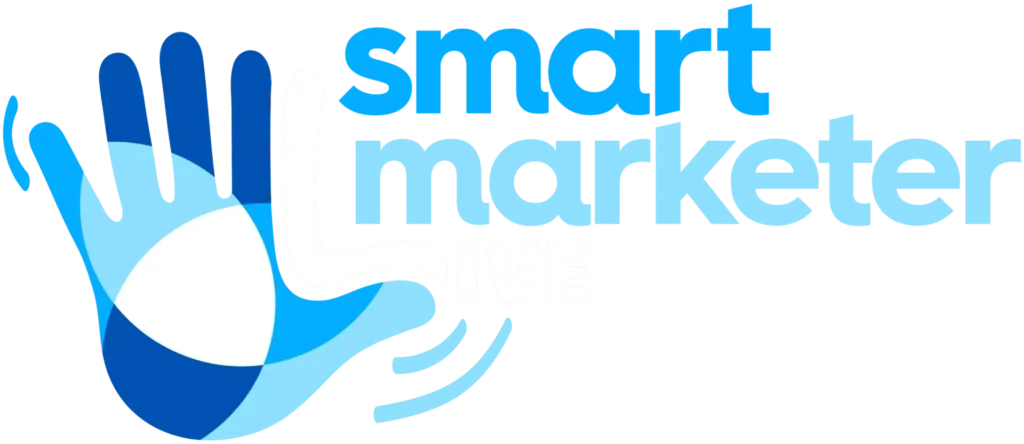
How should someone who’s new to advertising spend their first $1,000 on Meta ads?
A while back, we posed that question to a few of our top media buyers at the Smart Marketer Agency — and it became one of our most popular blog posts ever.
But a lot has changed since then when it comes to Meta ads. What hasn’t changed, though, is that new and experienced media buyers are always looking for ways to maximize the ROI on their ad spend.
So we just gave our article a 2025 update, with new insights from 3 ace media buyers in their own words.
In this article, you’ll learn:
- Why the most important part of media buying comes before you spend a dime
- How new media buyers should approach their ad copy, creative, account structure & more
- And what you can learn from Abraham Lincoln — yes, Honest Abe — about running successful ads
“The most important step is to do thorough research upfront.” –Dilyana, Manager of Advertising
When managing your first $1,000 in Meta ad spend, the most important step is to do thorough research upfront. This ensures you’re not making decisions blindly but instead basing them on what has already shown potential.
Here’s how I would approach the research, and how I would spend this budget to maximize results.
Step 1: Research and Build Your Assets
Creatives
I would begin by reviewing all available content assets, such as organic posts on Instagram and Facebook (if any). I’d identify posts with the best engagement — high reach, likes, comments, and shares — to spot patterns.
Additionally, I’d research competitors’ ads using Meta’s and TikTok’s ad libraries. Ads that have been running for a long time are often top performers, so I’d take note of those for inspiration. I always keep an eye on my own feed for fresh ideas as well.
Based on this research, I’d create 4–6 ads — split evenly between images and videos — designed to test a range of creative angles.
(For help producing your creative, check out our Ad Creative Mini-class.)
Copywriting
I’d study the copy from my competitors’ top-performing ads, saving examples in a document for reference.
Once my research is complete, I’d write 2 versions of the copy: one short and one long. The goal would be to create distinct variations — not just in length, but in how they approach the offer.
To guide my writing, I’d analyze the patterns I observed during my research.
For example, identifying repeated structures, emotional triggers, or calls to action and mimicking those elements in my unique style. (AI tools like ChatGPT can be helpful for structuring and refining copy.)
The most important part of the copy is the first few sentences (the hook), so I spend 90% of my time on that. The hook needs to call out my audience and show them I can solve their problem!
Audience Research
Next, I’d dive deep into audience research. Using a customer avatar template, I’d explore details such as:
- Demographics
- Interests
- Habits
- Media preferences, etc.
I’d also read comments on competitor ads and reviews, as well as any organic engagement on my own content, to gain a clearer picture of the audience’s pain points and desires.
Once I’ve gathered these insights, I’d use them to build a list of interests available for targeting within the Meta Ads Manager.
Step 2: Launch My First Campaign
I’d launch my first campaign going to cold audience as an ABO (Ad Set Budget Optimization) campaign, optimizing for purchases.
It would include 3 ad sets, each targeting a different interest audience. I’d aim for audiences between 1–10 million people to ensure they’re not too broad or too narrow.
Each ad set would contain the same 6–10 creative variations, ensuring enough diversity to identify winning combinations between creatives and copy.
Budget: The budget would depend on the product price point, but I’d typically allocate $50–$150 per day.
Retargeting: To ensure enough data for effective optimization, I’d not begin retargeting until I’ve generated at least 10,000 people in my retargeting audiences.
When retargeting, I’d use a minimal budget to avoid overwhelming frequency. Ideally, I’d keep frequency below 6 over the last 7 days. If people see my ad more than 5x times in a week and don’t purchase, they’re unlikely to convert soon anyway.
Step 3: Optimize, Learn, and Improve
After the campaign launches, I’d begin analyzing performance metrics to guide my optimization decisions. I’d start optimizing after the campaign had been running at least 1 day, and if the budget was very low, even 2 days.
Here is what I am going to be looking for:
Key Metrics to Monitor:
- CPM: Is the CPM reasonable for my industry? (e.g., $100+ might indicate issues with the ad account, audience size, or website quality.)
- CTR (Link Click): This should ideally be around 1%.
- If the CTR way lower (<0.40% for example), then the creatives might not be resonating with the audience and I should probably change something.
- If my CTR is amazing but I don’t have sales, there is a problem either with the website or with the ad being too click-baity. So people are clicking on it thinking they will get something that they don’t.
- CPC (Link Click) vs Cost Per Landing Page View: If there is a big difference between CPC and cost per landing page view, then either…
- My website is isn’t loading and I need to improve the load speed
- Or most of my spend is going to a placement like an Audience network (games for example) where people click on my ads unintentionally and don’t wait for my site to load. In that case, I would just exclude the placement that is giving me these results.
- Conversion Rate (CVR): I would check to see if the reason why my ads are not working is in the website by checking the CVR and I will even break it down into key stages:
- Link Click ? Landing Page View
- Landing Page View ? Content View
- Content View ? Add to Cart
- Add to Cart ? Initiate Checkout
- Initiate Checkout ? Purchase
By segmenting the funnel this way, I can pinpoint where the drop-off is happening and make necessary adjustments there on the website.
Tracking Check: I’d verify that tracking is properly set up. If Shopify reports sales but Meta doesn’t, it could indicate a pixel setup issue.
Optimization Process: After the first 1 or 2 days, I’d begin turning off underperforming ads. From there, I’d rinse and repeat, launching a new batch of ads based on the results of the first round. Typically, after 2–3 rounds of testing, I will have a clear idea of what’s working and can start scaling those winning combinations.
“When you start running ads, you’re essentially buying data by testing campaigns and analyzing their performance.” –Denis, Director of Advertising
There are different ways to approach spending your first $1,000 based on the stage of your business, the resources available to you for creative production, and your business goals.
So I will start with the following 4 assumptions:
- You have a new business
- You don’t get much traffic from channels other than Meta (or no traffic at all)
- You haven’t run Meta ads before, so your pixel doesn’t have data about who your best customers are
- And you have limited resources for creative production
With all these in mind, here are my recommendations for an ecommerce business as well as an info business (lead gen) or service.
Set the right expectations.
To be honest, you probably won’t be able to crack Meta ads right away — and that’s alright!
Usually when you start, you don’t have a proven offer to use top-of-funnel (TOF), nor do you have a proven landing page, creatives, copy or targeting.
When you start running ads, you’re essentially buying data by testing campaigns and analyzing their performance. Then you can optimize, iterate and eventually get to the desired profitability rate.
So start with what you think has the highest chance of success, then don’t be afraid to pivot quickly and test different offers if you don’t immediately see results.
Choose your offer.
Ecommerce Businesses: For ecom, allocate most of your budget to testing your hero product (your best-seller) if you have sales data already. If not, focus on the one product that has the highest chance of success based on your initial research.
If you offer multiple products, again, allocate most of your budget to testing 1 or 2 of your best-sellers, but also allocate about 10% of your overall budget ($100 in this case) to setting up a campaign using dynamic product ads (or catalog ads) that will promote your entire product line.
The goal of that campaign is to let the algorithm decide which products to show more, and to find out if there is another product (besides your best-seller) that can actually work for new customer acquisition on Meta.
Info Businesses (Lead Generation): Start by testing 1 lead gen offer (a lead magnet, a webinar, etc.), but be ready to change that offer quickly if you seeing poor results (high cost-per-click, high cost-per-lead).
Determine meaningful and realistic benchmarks.
Benchmarks will tell you which ads to keep and which to turn off, and will help remove biases from your decision making. (But again, don’t expect great results right from the start!)
Ecommerce Businesses: I would set my goal to acquire customers for at least break-even. Set a target ROAS or CPA goal that will allow you to hit that benchmark first.
Info Businesses: Again I would set my goal to acquire customers for at least break-even. But due to the nature of this business type, it might take more time for a potential customer (a lead) to convert and pay any money.
So my advice for lead gen businesses is to spend their first $500 to acquire leads, then wait a couple days (or even weeks) to find out if these leads are going to turn into paying customers.
Then, based on how many people converted and the cost per lead, they could set more realistic benchmarks about what would be a good CPL in order to at least break even.
Implement an account structure.
Keep it simple. The best way to start is with 1 testing campaign:
- Set up a manual conversion campaign with the goal of getting sales or leads (depending on your business).
- Set the daily budgets manually for each ad set and have different ad sets to test different things (i.e., your offer, creative, copy, or targeting). This will allow you to control how much you spend on each of these test variables.
There’s no need to set a retargeting campaign at this point, especially if you’re not currently getting much traffic.
My goal would be to see if Meta ads can work as a tool for new customer acquisition first. Then I would focus on the retargeting as we get more traffic from our acquisition efforts.
Set your starting budget.
Run all ad sets with the lowest possible daily budget — I’d recommend 1X your target CPA or CPL.
This will enable you to run more tests at once. And be ready to turn off ads or ad sets aggressively if they are far from your target CPA or CPL.
Remember, at the start we’re primarily buying data that will allow us to make a breakthrough. And with a limited budget, we need to quickly find something that works, so be ready to turn off everything that’s not producing good results and double down on what looks promising.
Choose your ad creatives.
With the assumption that you won’t have the resources to make a lot of different creatives, I would start by testing image ads first. (Videos work great too, but they usually require more resources to produce.)
I would recommend these creative types/concepts, as they could easily be produced and we know they work well across multiple brands and industries:
Native-looking “sticky note” ads: For an ecom example, check out this ad from Arrae:

For info businesses, a few great example are this ad from Aminos AI, this one from Adzooma, and just for fun — this one from us at Smart Marketer.
Image ads with feature/benefit callouts: These basic image ads are really effective. You’ve probably seen a ton of them. Here’s an example from Huel Bars:

Native ad focused around a person: For lead gen businesses you can do a simple image of the founder, like this one from us at Smart Marketer:

Or for ecommerce, you can feature a customer holding your product — like this one from BOOM!.
These creatives work so well because they don’t look like ads. They look like a normal post your might see on Facebook or Instagram. They’re also super easy to produce!
Also, because the images don’t reveal a lot of information about the offer, these creatives are great for testing ad copy (because people will be drawn to read the ad copy to learn more).
If you don’t have any video creative, try using 1 image per hook to test as a proof of concept. Then if you see promising results, you can invest in the creation of a video for that hook.
What copy would I use?
Don’t test too many copy variations at once. But if possible, try testing at least 1 long-form and 1 short-form.
Once you have copy that works well enough, focus on testing different creatives with that copy, as finding a winning creative is the #1 priority. When you have that, you can start testing different copy variations with that creative.
You can check out some copy examples in the links to ads I shared above.
(And if you need more help writing copy, read this short article on how to use A.I. to write killer copy and perform avatar research.)
What landing page would I use?
For ecom, the best place to start is probably running ads directly to a product page.
For info, to your opt-in page.
Consider making changes to the landing page if you’re seeing good CPC but terrible conversion rate.
How to decide which tests to stop and what’s working?
I would advise looking primarily at these metrics:
- CPM
- CTR
- CPC
- CPL (for info businesses)
- Cost per add to cart (for ecommerce)
- Cost per checkout (for ecommerce)
- Cost per purchase (for ecommerce)
- ROAS
- Conversion rate on the landing page
If you’re new to running ads on Meta, it will be difficult to know immediately what would be a good CPC, or a good CTR, or a good cost per checkout.
So I would recommend 2 things:
- Try to determine your breakeven CPA/CPL first. Then, based on the data from spending your first $100–200 on ads, try to reverse engineer what would be a good benchmark for all other metrics.
For example: as an info business, you’ve determined that your ideal CPL is $10. Based on the data from spending your first $100–200 on ads, you get a $4 CPC, 20% conversion rate on the landing page, and a $20 CPL. Based on this data, you see that in order to get a $10 CPL, you need to lower the CPC, or increase the conversion rate on the page, or both. You can apply the same logic for an ecom business. - Check out our amazing Facebook ads performance report. It includes real data from different businesses that you can use for inspiration, but also to understand what might be a good CPC or conversion rate for your business.
This has been Denis, Director of Advertising at the Smart Marketer Agency. That’s it for me — I hope it’s been helpful!
” ‘Give me 6 hours to chop down a tree, and I will spend the first 4 sharpening the axe.’ –Abraham Lincoln” –PEPIJN HUFEN, CEO
When I was first learning paid ads in 2017, I had just moved back in with my parents. I was pretty much broke and couldn’t afford to live by myself. But I had determination, and a dream to get something going for myself.
So with shaking hands, from my parents’ study, I launched my very first ads at $5 per day.
Now I’m the CEO of the Smart Marketer Agency, where we get to work with clients ranging from 7 to 10 figures — and all of them, at one point, also started with a new ad account and zero daily spend.
So trust when I say that, well before contributing to this post, I’ve thought long and hard about how to spend that first $1,000 on Meta ads.
And here’s the beauty of direct response advertising: it allows you to start from zero and gain momentum.
Using direct response ads to test your product, offer or messaging.
The goal isn’t necessarily to make a profit right away but to gain feedback and acquire your first customers. And with a small budget, you can test if your product, offer, or messaging has potential.
Abraham Lincoln said, “Give me 6 hours to chop down a tree, and I will spend the first 4 sharpening the axe.”
That’s exactly what I’d do with $1,000 in ad spend. Launching ads is the last phase; preparation is where you should focus if you want to minimize wasted time and maximize output.
It’s not about becoming an expert marketer, copywriter, or videographer. It’s about determining if your product or service has potential, and if it can acquire customers with Meta ads.
So let’s dive into the process, starting with the 4 components of a successful Meta ads strategy:
- Product or offer
- Landing page
- Ad account setup
- Creatives
Product or offer: What are you selling?
Of the 4 components, the product or offer is the most important, and is where I’ll spend most of my time in this post.
If your product is amazing, it will compensate for many shortcomings in your marketing strategy. Ideally, your product should be:
- Unique — either in what it does, how it does it, or at least how it looks
- Solve a problem
- Or help people achieve a desired end state
Selling generic products like towels or cutlery is harder on Facebook or Instagram because they lack distinction or appeal.
Social media platforms like Facebook and Instagram are about grabbing attention, which is why your product needs to be novel, appealing, and solve a problem to stand out.
(And if your product can’t be advertised on Meta at all — either because it’s non-compliant or lacks appeal — then I wouldn’t recommend starting that business.)
Okay, let’s move on to the next steps.
Landing pages: Where are you sending your traffic?
If you’re just getting started with Meta ads, then you probably don’t have much data on what’s converting in terms of landing pages for your products.
So the best thing to do is to model your sales page or product page after those you know are converting.
To do that, start by taking inspiration from your competitors’ pages. You can copy what they’re doing, then gather data and optimize from there.
You also want to use landing page best practices, like Ezra talks about in this article from our sister site, Zipify, on how to optimize your product pages for 8 figures.
Ad account setup: How is your ad account structured?
Here’s how I suggest you set up your account:
- Start with an ABO (ad set budget optimization) campaign
- Set your budget at $50/day per ad set
- And create 8 ad variations — 2 images and 2 videos, with 2 copy options for each
I believe this is the best way to stretch out your budget over enough options to gather data and find a winner.
Creatives: What ads are being shown?
I just mentioned the number of ad variations you should produce (8), but what should your actual creatives look like?
I know Denis mentioned a few of his favorite starter ads in the section above. Aside from that, you should study competitors’ ads for inspiration, and test human-centric and product-centric images and videos.
A final tip: always write ad copy with context and specificity. (If you need help, refer to this article on using AI to write killer ad copy.)
Test, gather data and iterate.
Using these 4 components, try to test quickly and adjust based on feedback.
Remember, the goal isn’t to become an expert at everything; the goal is to find momentum, even if the first attempts fail.
Test quickly, gather data, and iterate. Good luck!
* * * * *
Hey! Molly again.
Thanks so much for reading this article. I hope it was helpful hearing how a few of our most experience media buyers would spend their first $1,000 on Meta if they had to start from square one.
As some of these guys mentioned in their sections — if you want help creating powerful ads that resonate with your audience, then check out our Ad Creative Mini-class.
See you next time!



